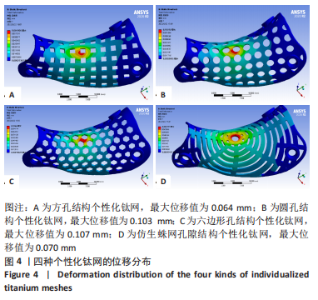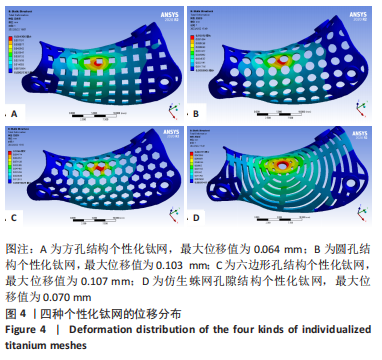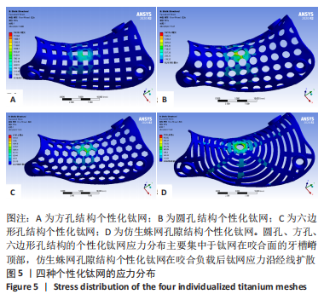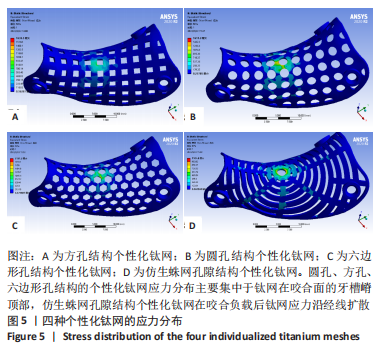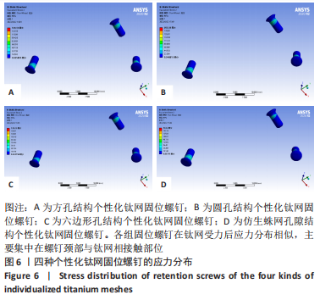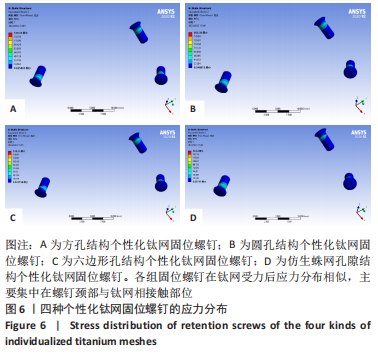Chinese Journal of Tissue Engineering Research ›› 2023, Vol. 27 ›› Issue (30): 4796-4801.doi: 10.12307/2023.544
Previous Articles Next Articles
Design and three-dimensional finite element analysis of 3D printed individualized titanium mesh with a bionic porous spider web-shaped structure
Zhang Liang1, 2, 3, Han Zekui1, 2, 3, Zang Yixin1, 2, 3, Han Zhenjia1, 2, 3, Wang Xinyu1, 2, 3
- 1The Key Laboratory of Biomedical Materials and Clinical Application in Heilongjiang Province, Jiamusi 154002, Heilongjiang Province, China; 2Experimental Center for Stomatological Engineering, 3School of Stomatology, Jiamusi University, Jiamusi 154002, Heilongjiang Province, China
-
Received:2022-07-26Accepted:2022-09-06Online:2023-10-28Published:2023-04-01 -
Contact:Wang Xinyu, Associate chief physician, Master’s supervisor, The Key Laboratory of Biomedical Materials and Clinical Application in Heilongjiang Province, Jiamusi 154002, Heilongjiang Province, China; Experimental Center for Stomatological Engineering and School of Stomatology, Jiamusi University, Jiamusi 154002, Heilongjiang Province, China -
About author:Zhang Liang, Master candidate, The Key Laboratory of Biomedical Materials and Clinical Application in Heilongjiang Province, Jiamusi 154002, Heilongjiang Province, China; Experimental Center for Stomatological Engineering and School of Stomatology, Jiamusi University, Jiamusi 154002, Heilongjiang Province, China -
Supported by:Foundation for Young Talents in Jiamusi University in 2022, No. JMSUQP2022028 (to ZYX); the Natural Science Foundation of Heilongjiang Province, No. LH2022H089 (to WXY)
CLC Number:
Cite this article
Zhang Liang, Han Zekui, Zang Yixin, Han Zhenjia, Wang Xinyu. Design and three-dimensional finite element analysis of 3D printed individualized titanium mesh with a bionic porous spider web-shaped structure[J]. Chinese Journal of Tissue Engineering Research, 2023, 27(30): 4796-4801.
share this article
Add to citation manager EndNote|Reference Manager|ProCite|BibTeX|RefWorks
| [1] CHA HS, KIM JW, HWANG JH, et al. Frequency of bone graft in implant surgery. Maxillofac Plast Reconstr Surg. 2016;38(1):19. [2] BRIGUGLIO F, FALCOMATÀ D, MARCONCINI S, et al. The Use of Titanium Mesh in Guided Bone Regeneration: A Systematic Review. Int J Dent. 2019;2019:9065423. [3] TOLSTUNOV L, HAMRICK JFE, BROUMAND V, et al. Bone Augmentation Techniques for Horizontal and Vertical Alveolar Ridge Deficiency in Oral Implantology. Oral Maxillofac Surg Clin North Am. 2019;31(2):163-191. [4] RA G, WO Q. Bone regeneration in dentistry: an overview. J Biol Regul Homeost Agents. 2021;35(1 Suppl.1):37-46. [5] CHIAPASCO M, ZANIBONI M, BOISCO M. Augmentation procedures for the rehabilitation of deficient edentulous ridges with oral implants. Clin Oral Implants Res. 2006;17 Suppl 2:136-159. [6] CUCCHI A, VIGNUDELLI E, FIORINO A, et al. Vertical ridge augmentation (VRA) with Ti-reinforced d-PTFE membranes or Ti meshes and collagen membranes: 1-year results of a randomized clinical trial. Clin Oral Implants Res. 2021;32(1):1-14. [7] NAENNI N, STUCKI L, HÜSLER J, et al. Implants sites with concomitant bone regeneration using a resorbable or non-resorbable membrane result in stable marginal bone levels and similar profilometric outcomes over 5 years. Clin Oral Implants Res. 2021;32(8):893-904. [8] CUCCHI A, VIGNUDELLI E, NAPOLITANO A, et al. Evaluation of complication rates and vertical bone gain after guided bone regeneration with non-resorbable membranes versus titanium meshes and resorbable membranes. A randomized clinical trial. Clin Implant Dent Relat Res. 2017;19(5):821-832. [9] GU C, XU L, SHI A, et al. Titanium Mesh Exposure in Guided Bone Regeneration Procedures: A Systematic Review and Meta-analysis. Int J Oral Maxillofac Implants. 2022;37(1):e29-e40. [10] MAIORANA C, FONTANA F, DAL POLO MR, et al. Dense Polytetrafluoroethylene Membrane versus Titanium Mesh in Vertical Ridge Augmentation: Clinical and Histological Results of a Split-mouth Prospective Study. J Contemp Dent Pract. 2021;22(5):465-472. [11] 郭雪琪,陈韵欣,杨岚,等.3D打印个性化钛网修复严重牙槽骨缺损的短期效果观察[J].中国口腔种植学杂志,2021,26(6):368-375. [12] HARTMANN A, SEILER M. Minimizing risk of customized titanium mesh exposures - a retrospective analysis. BMC Oral Health. 2020;20(1):36. [13] LIZIO G, PELLEGRINO G, CORINALDESI G, et al. Guided bone regeneration using titanium mesh to augment 3-dimensional alveolar defects prior to implant placement. A pilot study. Clin Oral Implants Res. 2022;33(6):607-621. [14] PENG WM, LIU YF, JIANG XF, et al. Bionic mechanical design and 3D printing of novel porous Ti6Al4V implants for biomedical applications. J Zhejiang Univ Sci B. 2019;20(8):647-659. [15] KAEWUNRUEN S, NGAMKHANONG C, XU S. Large amplitude vibrations of imperfect spider web structures. Sci Rep. 2020;10(1):19161. [16] 邓欢,田茂欢.集中荷载与风载作用下蜘蛛网变形行为研究[J].湖北大学学报(自然科学版),2018,40(5):496-500+506. [17] SU I, NARAYANAN N, LOGRONO MA, et al. In situ three-dimensional spider web construction and mechanics. Proc Natl Acad Sci U S A. 2021;118(33):e2101296118. [18] 王心彧,张亮,韩泽奎,等.用于牙槽骨增量的钛网的设计及制作方法,CN113520638A[P/OL]. 2021-06-18. https://d.wanfangdata.com.cn/patent/CN202110676172.0 [19] BAI L, JI P, LI X, et al. Mechanical Characterization of 3D-Printed Individualized Ti-Mesh (Membrane) for Alveolar Bone Defects. J Healthc Eng. 2019;2019:4231872. [20] SARRAFPOUR B, SWAIN M, LI Q, et al. Tooth eruption results from bone remodelling driven by bite forces sensed by soft tissue dental follicles: a finite element analysis. PLoS One. 2013;8(3):e58803. [21] CHIAPASCO M, CASENTINI P, TOMMASATO G, et al. Customized CAD/CAM titanium meshes for the guided bone regeneration of severe alveolar ridge defects: Preliminary results of a retrospective clinical study in humans. Clin Oral Implants Res. 2021;32(4):498-510. [22] LI S, ZHANG T, ZHOU M, et al. A novel digital and visualized guided bone regeneration procedure and digital precise bone augmentation: A case series. Clin Implant Dent Relat Res. 2021;23(1):19-30. [23] SUMIDA T, OTAWA N, KAMATA YU, et al. Custom-made titanium devices as membranes for bone augmentation in implant treatment: Clinical application and the comparison with conventional titanium mesh. J Craniomaxillofac Surg. 2015;43(10):2183-2188. [24] SAGHEB K, SCHIEGNITZ E, MOERGEL M, et al. Clinical outcome of alveolar ridge augmentation with individualized CAD-CAM-produced titanium mesh. Int J Implant Dent. 2017;3(1):36. [25] SOLDATOS NK, STYLIANOU P, KOIDOU VP, et al. Limitations and options using resorbable versus nonresorbable membranes for successful guided bone regeneration. Quintessence Int. 2017;48(2):131-147. [26] CUCCHI A, BIANCHI A, CALAMAI P, et al. Clinical and volumetric outcomes after vertical ridge augmentation using computer-aided-design/computer-aided manufacturing (CAD/CAM) customized titanium meshes: a pilot study. BMC Oral Health. 2020;20(1):219. [27] SEILER M, KÄMMERER PW, PEETZ M, et al. Customized lattice structure in reconstruction of three-dimensional alveolar defects. Int J Comput Dent. 2018;21(3):261-267. [28] SUMIDA T, OTAWA N, KAMATA YU, et al. Custom-made titanium devices as membranes for bone augmentation in implant treatment: Clinical application and the comparison with conventional titanium mesh. J Craniomaxillofac Surg. 2015;43(10):2183-2188. [29] 孟文侠,胡亚利.个性化钛网联合屏障膜在引导骨再生修复牙槽骨缺损中的应用效果[J].医学临床研究,2022,39(6):862-865. [30] 王献利,王国庆,赵西博,等.钛网在上前牙唇侧重度骨缺损种植中的临床研究[J].中华老年口腔医学杂志,2021,19(1):26-30. [31] XIE Y, LI S, ZHANG T, et al. Titanium mesh for bone augmentation in oral implantology: current application and progress. Int J Oral Sci. 2020; 12(1):37. [32] 白丽云.用于牙槽骨增量的3D打印个性化钛网的生物力学研究[D].重庆:重庆医科大学,2019. [33] RAKHMATIA YD, AYUKAWA Y, JINNO Y, et al. Micro-computed tomography analysis of early stage bone healing using micro-porous titanium mesh for guided bone regeneration: preliminary experiment in a canine model. Odontology. 2017;105(4):408-417. [34] GUTTA R, BAKER RA, BARTOLUCCI AA, et al. Barrier membranes used for ridge augmentation: is there an optimal pore size? J Oral Maxillofac Surg. 2009;67:1218-1225. [35] SENOO M, HASUIKE A, YAMAMOTO T, et al. Comparison of Macro-and Micro-porosity of a Titanium Mesh for Guided Bone Regeneration: An In Vivo Experimental Study. In Vivo. 2022;36(1):76-85. [36] DELLAVIA C, CANCIANI E, PELLEGRINI G, et al. Histological assessment of mandibular bone tissue after guided bone regeneration with customized computer-aided design/computer-assisted manufacture titanium mesh in humans: A cohort study. Clin Implant Dent Relat Res. 2021;23(4):600-611. [37] HER S, KANG T, FIEN MJ. Titanium mesh as an alternative to a membrane for ridge augmentation. J Oral Maxillofac Surg. 2012;70: 803-810. [38] TAMADDON M, SAMIZADEH S, WANG L, et al. Intrinsic Osteoinductivity of Porous Titanium Scaffold for Bone Tissue Engineering. Int J Biomater. 2017;2017:5093063. [39] 吴文孟,张倩,宁宝麟,等.3D打印Ti-6Al-4V合金机械性能研究[J].全科口腔医学电子杂志,2016,3(10): 93-95. [40] 程康杰.修复下颌骨缺损的复合结构植入体优化设计及制备研究[D].杭州:浙江工业大学,2020. [41] YAN W, DING M, KONG B, et al. Lightweight Splint Design for Individualized Treatment of Distal Radius Fracture. J Med Syst. 2019; 43(8):284. [42] QIN Z, COMPTON BG, LEWIS JA, et al. Structural optimization of 3D-printed synthetic spider webs for high strength. Nat Commun. 2015;6:7038. [43] 张世梁.基于蜘蛛网结构的伞状可展机构设计与分析[D].长春:长春工业大学,2019. [44] AOYANAGI Y, OKUMURA K. Simple model for the mechanics of spider webs [published correction appears in Phys Rev Lett. 2015;115(3):039903]. Phys Rev Lett. 2010;104(3):038102. |
| [1] | Lu Jieming, Li Yajing, Du Peijie, Xu Dongqing. Effects of artificial turf versus natural grass on biomechanical performance of the lower limbs in young females during jump-landing [J]. Chinese Journal of Tissue Engineering Research, 2025, 29(6): 1101-1107. |
| [2] | Zhao Hongxia, Sun Zhengwei, Han Yang, Wu Xuechao , Han Jing. Osteogenic properties of platelet-rich fibrin combined with gelatin methacryloyl hydrogel [J]. Chinese Journal of Tissue Engineering Research, 2025, 29(4): 809-817. |
| [3] | Zhao Yuxin, Liang Liang, Jin Feng, Xu Yangyang, Kang Zhijie, Fang Yuan, He Yujie, Wang Xing, Wang Haiyan, Li Xiaohe. Establishment and stress analysis of a finite element model for adolescent cervical disc herniation [J]. Chinese Journal of Tissue Engineering Research, 2025, 29(3): 448-454. |
| [4] | Li Zhenggang, Shang Xuehong, Wu Zhang, Li Hong, Sun Chaojun, Chen Huadong, Sun Zhe, Yang Yi. Finite element analysis of three internal fixation modalities for treatment of Pauwels type III femoral neck fractures under different loading conditions [J]. Chinese Journal of Tissue Engineering Research, 2025, 29(3): 455-463. |
| [5] | Liu Mengfei, Chen Gang, Shi Yihan, Zeng Lin, Jiang Kan, Yilihamujiang•Wusiman. Finite element analysis of optimization of femoral prosthesis implantation position in unicompartmental knee arthroplasty in osteoporotic patients [J]. Chinese Journal of Tissue Engineering Research, 2025, 29(3): 464-470. |
| [6] | Wang Zilong, Meng Xin, Zhang Zhiqi, Xie Yu, Meng Lingyue, Zhang Qiuxia, Kong Lingyu. Biomechanical characteristics of lower extremities during counter movement jump in male patients with functional ankle instability [J]. Chinese Journal of Tissue Engineering Research, 2025, 29(3): 478-485. |
| [7] | Liang Jiyao, Zhou Honghai, Wei Guikang, Su Shaoting, Chen Longhao, He Xinyu, Liu Liangpu. Quantification of in vivo biomechanics and analysis of influencing factors in cervical spine fixed-point rotation manipulation [J]. Chinese Journal of Tissue Engineering Research, 2025, 29(3): 486-492. |
| [8] | Wang X, Wang Hm, Chen Sh, Feng Tx, Bu Hm, Zhu Lg, Chen Dd, Wei X. Stress and morphological characteristics of intervertebral foramen of cervical rotation-traction manipulation for treating cervical spondylotic radiculopathy: a three-dimensional finite element analysis [J]. Chinese Journal of Tissue Engineering Research, 2025, 29(3): 441-447. |
| [9] | Su Dejun, Dong Wanpeng, Dong Yuefu, Zhang Jichao, Zhang Zhen. Design of asymmetric prosthesis and mechanical analysis of total knee arthroplasty [J]. Chinese Journal of Tissue Engineering Research, 2025, 29(3): 510-516. |
| [10] | He Kai, Xing Wenhua, Liu Shengxiang, Bai Xianming, Zhou Chen, Gao Xu, Qiao Yu, He Qiang, Gao Zhiyu, Guo Zhen, Bao Aruhan, Li Chade. Constructing a model of degenerative scoliosis using finite element method: biomechanical analysis in etiology and treatment [J]. Chinese Journal of Tissue Engineering Research, 2025, 29(3): 572-578. |
| [11] | Gao Xilin, Wu Si Zhang Chao Zhu Liguo, Fu Bifeng, Wang Ping. Mechanotransduction proteins in intervertebral disc degeneration [J]. Chinese Journal of Tissue Engineering Research, 2025, 29(3): 579-589. |
| [12] | Li Zhifei, Yang Yin, Chen Hualong, Liang Qinqiu, Zhong Yuanming, Zhang Yisheng. Finite element analysis of the correlation between tilt angle of titanium cage and postoperative subsidence of titanium cage after anterior subtotal cervical corpectomy, decompression and fusion [J]. Chinese Journal of Tissue Engineering Research, 2024, 28(9): 1313-1319. |
| [13] | Chen Mengmeng, Bao Li, Chen Hao, Jia Pu, Feng Fei, Shi Guan, Tang Hai. Biomechanical characteristics of a novel interspinous distraction fusion device BacFuse for the repair of lumbar degenerative disease [J]. Chinese Journal of Tissue Engineering Research, 2024, 28(9): 1325-1329. |
| [14] | Liang Cheng, Zhang Linqi, Wang Guan, Li Wen, Duan Ke, Li Zhong, Lu Xiaobo, Zhuo Naiqiang. Finite element and biomechanical analysis of different implants in repair for unilateral unstable pelvic posterior ring injury [J]. Chinese Journal of Tissue Engineering Research, 2024, 28(9): 1336-1341. |
| [15] | Yang Junliang, Lu Tan, Xu Biao, Jiang Yaqiong, Wang Fucheng. Three-dimensional finite element analysis of effects of partial anterior cruciate ligament rupture on knee joint stress [J]. Chinese Journal of Tissue Engineering Research, 2024, 28(9): 1347-1353. |
| Viewed | ||||||
|
Full text |
|
|||||
|
Abstract |
|
|||||
